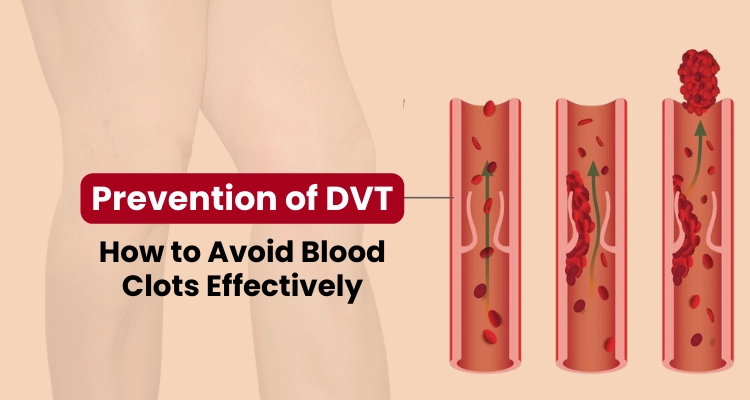Prevention of DVT (Deep Vein Thrombosis) is prominent. This is because blood clots in the legs may cause serious health concerns if not noticed early. Sometimes, DVT occurs quietly without giving any clear signs. Swelling, pain, or color change can sometimes occur in the leg. There could be life-threatening complications such as pulmonary embolism if not treated properly and in a timely manner.
Prevention can be done in simple daily habits. Some of them are keeping your body active, drinking plenty of water, and following precautions that keep your blood flow well. In this blog, you will come to know how to prevent blood clots effectively and stay away from the complications of DVT.
1. Remain Active During Travel
Be it a short or long trip, don’t sit in the same spot for hours. Wondering why? It can slow your blood flow in your legs and may increase the risk of DVT. With this in mind, keep your feet moving by standing or walking for a few minutes every hour.
When you are seated, stretch your legs regularly, do not cross your legs, and consider taking little motions like flexing your ankles. These actions allow your blood to move as it is meant to do and help keep the effects of prolonged sitting from catching up with you.
2. Make Use of Compression Stockings
Wearing compression stockings is one of the simplest ways to lower the risk of DVT. They place gentle pressure on your legs and help blood flow back toward the heart rather than clotting in the veins.
Before you buy, understanding varicose veins vs DVT is important because both conditions affect circulation differently. These stockings are available in different sizes and compression levels. So, you can choose the right one that fits you. Make sure to wear these stockings while you travel, do office work, or engage in general activity, as they can ease circulation and prevent blood clots after surgery.
3. Exercise Regularly
Regular exercise helps avoid blood clots. Circulation improves, and you will maintain a healthy weight when you move your body. You can keep your veins working with various activities. It includes walking, swimming, or cycling. Further, exercise also strengthens muscles and promotes heart conditioning and health. Thus, exercise promotes strong blood circulation.
By starting slow and increasing slowly as needed, you can establish a consistent routine. This is especially true if you have not exercised. Consult a vascular specialist before starting any new exercise routine that will be suitable for your condition.
4. Take Breaks from Sitting
Prolonged sitting raises clot risk, particularly at the workplace. Plan short walks around your office, do calf stretches, or consider foot flexing under the desk.
If walking is not an option, even standing or ankle rotation stimulates blood circulation. Set phone or computer reminders for frequent movement. These small changes during the day help in blood clotting prevention and lower the risk of DVT successfully.
5. Make Smart Travel Choices
If preparing for travel, prepare properly and support the prevention of DVT by way of example, wear loose-fitting clothing, drink water rather than caffeine or alcohol, and keep blood flow managed by moving about as much as you can.
When you are aware of the early signs of DVT, you can plan your routine accordingly. It is better to discuss precautions with DVT specialists if you are taking any medications, who can guide you the best.
6. Stop Smoking
The causes of blood clots in legs often include smoking. Smoking destroys blood vessels, restricts flow, and greatly increases the chance of clotting. Stopping smoking reduces DVT risk shortly after, as well as improving heart and lung health.
Although attempts to quit before may not have succeeded, continue to try, as each attempt moves you closer to victory. Take therapies or medications with your physician that will make quitting easier and more successful for your overall health.
Conclusion
Prevention of DVT is all about making lifestyle changes and following the guidance of experts. Being active, wearing compression stockings, and reducing stress are the basics to reduce the risks.
To get advanced treatment, make an appointment with Dr. Kunal Arora, a top-ranked Vascular and Interventional Radiologist in Mumbai. With 9+ years of experience at the Endovascular Care Centre, he deals with minimally invasive solutions for DVT, varicose veins, and other vascular problems.
Call now to confirm your consultation and set yourself up for lasting vascular health!
FAQs
1. What is the prevention of DVT?
The most important aspect of DVT prevention is blood circulation. Simple ideas are to get up frequently and move, elevate the legs, or wear compression stockings or socks.
2. What is the best approach to limit DVT risk?
Regular physical activity and exercise to promote blood flow represents the best approach to decreasing the risk of a DVT and maintaining a healthy body weight, and improving or developing muscle, decreasing the likelihood of DVT.
3. What increases the risk of developing a DVT?
The risk for developing DVT also increases with long periods of immobility. Injury to a vein and surgery, or conditions such as paralysis or an illness, can also increase the likelihood of developing a clot.


